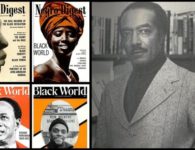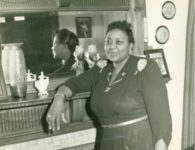The Oloko Protest saw 10,000 women converge on the Warrant Chief’s office and demand that Chief Okugo. They used took the approach of publicly shaming the Chief by “sitting on him.” The Igbo protesters would sit at the official’s place of residence or business and sing songs about why the person was being shamed or disrupt their private and professional life.
“Sitting on a man” can include many creative disruption tactics as long as it gains attention and the preferred outcome. While it may seem that it is associated with women-led protest, it has been employed by men against women. Today the practice exists while sitting in the offices of an elected official. The goal was to get the official removed and bring the taxation practices to light during the Women’s War.
The Women’s War saw prison officials overwhelmed by protesters and prisoners freed in one incident
OLOKO PROTEST LEADERSHIP
Oloko had three women—called the Oloko Trio—who organized the protest, kept everyone involved informed and motivated and directed their energy against the colonial government. Ikonnia, Mwanedia, and Nwugo served as the core and were most effective at keeping thing calm. As is usually the case with the native populace and colonial power, things escalated into violence with the colonial police killing a few protesters during a demonstration. Things never calmed down but the situation dispersed when law enforcement and the military were deployed.
While not included in that core leadership trio, Nwanyeruwa’s role was equally important in the Women’s War as she informed others of what happened. She also assisted in developing the strategy and non-violent tactics used in the revolt. She is highly revered as an important figure in the Women’s War.
PRESS DEPICTION OF THE WOMEN’S WAR
As with any political movement, action, or protest, it will be viewed differently depending on the eyes looking at it. Natives subjected to oppression by British colonial forces saw the protests favorably. Plus they would be familiar with the practices taken. As a result, it was looked at as a mainly nonviolent protest with its moments of escalation.
The British press and colonial government saw this as a violent rebellion—a riot, you could say. Having been the root of and the target so many over the centuries can make even largely non-violent protest seem hyper aggressive, after all. Being a patriarchal-based, the colonial government and press painted women involved in the protest as violent and hysterical.
Both views would influence the name of the revolt as either “The Women’s War” or “Aba Women’s Riot” among other names.
OUTCOME
The protests resulted in several commissions of inquiry. It was the second one that garnered major results. This inquiry saw hundreds of witnesses a little over a hundred being women and the other 382 being men. The women explained why they protested and disrupted the operation of the districts. Meanwhile, the men had to explain how they couldn’t establish and maintain order.
As for what was achieved, rapid and widespread mobilizing against this particular issue empowered women who didn’t have social power of an elevated class. This was a campaign initiated and carried out by women who were a part of the heavily taxed majority of the population.
As a result, women had more say in politics and governance depending on the district. It even resulted in women being assigned as chiefs.
Through the commissions, several chiefs lost their positions and a new administration was brought in. This new Native Administration implemented recommendations from the women, resulting in reform.
Due to the impact of the Women’s War, similar strategies and tactics were used when it came to other tax and labor protests in the future.
SOURCE: http://nvdatabase.swarthmore.edu/content/igbo-women-campaign-rights-womens-war-nigeria-1929





















No comments